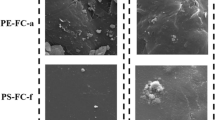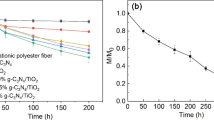Abstract
A poly(styrene-block-acrylic acid) containing TiO2 gel (PS-b-PAA/TiO2) polymer photocatalyst had the same density as PS and could provoke photocatalytic activity to PS particles in water. It showed photocatalytic activity to a PS containing a N–H type hindered amine light stabilizer (PS/LA-77) in water under the UV irradiation. The molecular weight decrease was ca. 10%, showing that a weaker light source and different kind of hindered amine light stabilizer (HALS) should be employed. The phthalocyanine modified photocatalyst had the activity under visible light irradiation. In addition, a N-OR type HALS (LA-81) loading worked as radical scavenger, showing that the PS autoxidation was certainly controlled. After the 144 h irradiation, the molecular weight was drastically decreased with the increases of heating temperature and time. When the heat treatment was performed by the enclosed sample with the aluminum foil, the molecular weight change behavior was considerably different between the PS and PS/LA-81. The difference was due to the chain scission mechanism. The intra-alkyl radical production in PS chain allowed controlling molecular weight by the heat treatment.










Similar content being viewed by others
References
Derraik JGB (2002) The pollution of the marine environment by plastic debris: a review. Mar Poll Bull 44(9):842–852
Barnes DKA, Galgani F, Thompson RC, Barlaz M (2009) Accumulation and fragmentation of plastic debris in global environments. Phil Trans R Soc B 364(1526):1985–1998
Thompson RC, Swan SH, Moore CJ, vom Saal FS (2009) Our plastic age. Phil Trans R Soc B 364(1526):1973–1976
Jambeck JR, Geyer R, Wilcox C, Siegler TR, Perryman M, Andrady A, Narayan R, Law KL (2015) Plastic waste inputs from land into the ocean. Science 347(6223):768–771
Halle AT, Ladirat L, Gendre X, Goudouneche D, Pusineri C, Routaboul C, Tenailleau C, Duployer B, Perez E (2016) Understanding the fragmentation pattern of marine plastic debris. Environ Sci Technol 50(11):5668–5675
Avio CG, Gorbi S, Regoli F (2017) Plastics and microplastics in the oceans: from emerging pollutants to emerged threat. Mar Environ Res 128:2–11
Yokota K, Waterfield H, Hastings C, Davidson E, Kwietniewski E, Wells B (2017) Finding the missing piece of the aquatic plastic pollution puzzle: interaction between primary producers and microplastics. Limnol Oceanogr Lett 2:91–104
Rummel CD, Jahnke A, Gorokhova E, Kühnel D, Schmitt-Jansen M (2017) Impacts of biofilm formation on the fate and potential effects of microplastic in the aquatic environment. Environ Sci Technol Lett 4:258–267
Law KL (2017) Plastics in the marine environment. Annu Rev Mar Sci 9:205–229
Michels J, Stippkugel A, Lenz M, Wirtz K, Engel A (2018) Rapid aggregation of biofilm-covered microplastics with marine biogenic particles. Proc R Soc B 285:1203–1211
Andrady AL (2011) Microplastics in the marine environment. Mar Poll Bull 62(8):1596–1605
Vianello A, Boldrin A, Guerriero P, Moschino V, Rella R, Sturaro A, Da Ros L (2013) Microplastic particles in sediments of lagoon of venice, Italy: first observations on occurrence, spatial patterns and identification. Estuarine Coastal Shelf Sci 130:54–61
Cole M, Lindeque P, Fileman E, Halsband C, Goodhead R, Moger J, Galloway TS (2013) Microplastic ingestion by zooplankton. Environ Sci Technol 47(12):6646–6655
Shang J, Chai M, Zhu Y (2003a) Solid-phase photocatalytic degradation of polystyrene plastic with TiO2 as photocatalyst. J Solid State Chem 174(1):104–110
Shang J, Chai M, Zhu Y (2003b) Photocatalytic degradation of polystyrene plastic under fluorescent light. Environ Sci Technol 37(19):4494–4499
Zan L, Tian L, Liu Z, Peng Z (2004) A new polystyrene-TiO2 nanocomposite film and its photocatalytic degradation. Appl Catal A: General 264(2):237–242
Kemp TJ, McIntyre RA (2006) Influence of transition metal-doped titanium(IV) dioxide on the photodegradation of polystyrene. Polym Deg Stab 91(12):3010–3019
Lobelle D, Cunliffe M (2011) Early microbial biofilm formation on marine plastic debris. Mar Poll Bull 62(1):197–200
Zettler ER, Mincer TJ, Amaral-Zettler LA (2013) Life in the ‘plastisphere’: microbial communities on plastic marine debris. Environ Sci Technol 47(13):7137–7146
Reisser J, Shaw J, Hallegraeff G, Proietti M, Barnes DKA, Thums M, Wilcox C, Hardesty BD, Pattiaratchi C (2014) Millimeter-sized marine plastics: a new pelagic habitat for microorganisms and invertebrates. PLoS ONE 9:e100289
Foulon V, Le Roux F, Lambert C, Huvet A, Soudant P, Paul-Pont I (2016) Colonization of polystyrene microparticles by vibrio crassostreae: light and electron microscopic investigation. Environ Sci Technol 50(20):10988–10996
Debroas D, Mone A, Ter Halle A (2017) Plastics in the north atlantic garbage patch: a boat-microbe for hitchhikers and plastic degraders. Sci Total Environ 599–600:1222–1232
Devriese LI, Witte BD, Vethaak AD, Hostens K, Leslie HA (2017) Bioaccumulation of PCBs from microplastics in norway lobster (Nephrops norvegicus): an experimental study. Chemosphere 186:10–16
Nor NHM, Koelmans AA (2019) Transfer of PCBs from microplastics under simulated gut fluid conditions is biphasic and reversible. Environ Sci Technol 53(4):1874–1883
Desilvestro J, Graetzel M, Kavan L, Moser J, Augustynski J (1985) Highly efficient sensitization of titanium dioxide. J Am Chem Soc 107(10):2988–2990
Chen LC, Chou TC (1993) Photobleaching of methyl orange in titanium dioxide suspended in aqueous solution. J Mol Catal 85(2):201–214
Perez DS, Castellan A, Grelier S, Terrones MGH, Machado AEH, Ruggiero R, Vilarinho AL (1998) Photochemical bleaching of chemical pulps catalyzed by titanium dioxide. J Photochem Photobiol A: Chem 115(1):73–80
Ferin J, Oberdörster G, Penney DP, Respir AJ (1992) Pulmonary retention of ultrafine and fine particles in rats. Cell Mol Biol 6(5):535–542
Oesch F, Landsiedel R (2012) Genotoxicity investigations on nanomaterials. Arc Toxicol 86(7):985–994
Wang J, Fan Y (2014) Lung injury induced by TiO2 nanoparticles depends on their structural features: size, shape, crystal phases, and surface coating. Int J Mol Sci 15(12):22258–22278
Nakatani H, Kawajiri G, Motokucho MS (2016) Polystyrene photodegradation with a styrene block copolymer containing TiO2 nanoparticle. Polym Deg Stab 130:135–142
Nakatani H, Hamachi R, Fukui K, Motokucho S (2018) Synthesis and activity characteristics of visible light responsive polymer photocatalyst system with a styrene block copolymer containing TiO2 gel. J Colloid Interface Sci 532:210–217
Arita S, Yamaguchi K, Motokucho S, Nakatani H (2017) Selective decomposition of hexabromocyclododecane in polystyrene with a photo and thermal hybrid treatment system. Polym Deg Stab 143:130–135
Turton TJ, White JR (2001) Effect of stabilizer and pigment on photo-degradation depth profiles in polypropylene. Polym Deg Stab 74(3):559–568
Schwetlick K, Habicher WD (2002) Antioxidant action mechanisms of hindered amine stabilisers. Polym Deg Stab 78(1):35–40
Micallef AS, Blinco JP, Georg GA, Reid DA, Rizzardo E, Thang SH, Bottle SE (2005) The application of a novel profluorescent nitroxide to monitor thermo-oxidative degradation of polypropylene. Polym Deg Stab 89(3):427–435
Nguyen TV, Tri PN, Nguyen TD, Aidani RE, Trinh VT, Decker C (2016) Accelerated degradation of water borne acrylic nanocomposites used in outdoor protective coatings. Polym Deg Stab 128:65–76
Gijsman P (2017) A review on the mechanism of action and applicability of hindered amine stabilizers. Polym Deg Stab 145:2–10
Gabaston LI, Jackson RA, Armes SP (1998) Living free-radical dispersion polymerization of styrene. Macromolecules 31(9):2883–2888
Qiu J, Charleux B, Matyjaszewski K (2001) Controlled/living radical polymerization in aqueous media: homogeneous and heterogeneous systems. Prog Polym Sci 26(10):2083–2134
Nakatani H, Nakamura T, Motokucho S (2018) A study on recyclable waterborne polyurethane process with a photo and thermal hybrid treatment system. React Funct Polym 127:168–176
Yamada S, Mouri E, Yoshinaga K (2011) J Polym Sci Pol Chem 49(3):712–718
Zhou J, Qiao Y, Wang W, Leng E, Huanga J, Yu Y, Xu M (2016) Formation of styrene monomer, dimer and trimer in the primary volatiles produced from polystyrene pyrolysis in a wire-mesh reactor. Fuel 182:333–339
Kruse TM, Woo OS, Wong HW, Khan SS, Broadbelt LJ (2002) Mechanistic modeling of polymer degradation: a comprehensive study of polystyrene. Macromolecules 35(20):7830–7844
Faravelli T, Pinciroli M, Pisano F, Bozzano G, Dente M, Ranzi E (2001) Thermal degradation of polystyrene. J Anal Appl Pyrol 60(1):103–121
Poutsma ML (2006) Mechanistic analysis and thermochemical kinetic simulation of the pathways for volatile product formation from pyrolysis of polystyrene, especially for the dimer. Polym Degrad Stab 91(12):2979–3009
McNeill IC, Zulfiqar M, Kousar T (1990) A detailed investigation of the products of the thermal degradation of polystyrene. Polym Degrad Stab 28(2):131–151
Carniti P, Beltrame PL, Armada M, Gervasini A, Audisio G (1991) Polystyrene thermodegradation. 2. Kinetics of formation of volatile products. Ind Eng Chem Res 30(7):1624–1629
Achilias DS, Kanellopoulou I, Megalokonomos P, Antonakou E, Lappas AA (2007) Chemical recycling of polystyrene by pyrolysis: potential use of the liquid product for the reproduction of polymer. Macromol Mater Eng 292(8):923–934
Ohtani H, Yuyama T, Tsuge S, Plage B, Schulten HR (1990) Study on thermal degradation of polystyrenes by pyrolysis-gas chromatography and pyrolysisfield ionization mass spectrometry. Eur Polym J 26(8):893–899
Hussain Z, Khan KM, Perveen S, Hussain K, Voelter W (2012) The conversion of waste polystyrene into useful hydrocarbons by microwave-metal interaction pyrolysis. Fuel Process Technol 94(1):145–150
Hussain Z, Khan KM, Hussain K (2010) Microwave–metal interaction pyrolysis of polystyrene. J Anal Appl Pyrol 89(1):39–43
Shin H, Bae S (2008) Thermal decomposition of polystyrene in supercritical methanol. J Appl Polym Sci 108:3467–3472
Hussain Z, Khan KM, Basheer N, Hussain K (2011) Co-liquefaction of makarwal coal and waste polystyrene by microwave–metal interaction pyrolysis in copper coil reactor. J Anal Appl Pyrol 90:53–55
Acknowledgements
This work was supported by the Grant-in-Aid for Scientific Research, No. 20K05587 from Japan Society for the Promotion of Science and by Nagasaki University organization for marine science and technology, respectively. The authors would like to thank ADEKA Co. for providing LA-77 and LA-81. This study made use of instruments (GPC & thermogravimetry) in the Advanced Material Science Research Unit Sharing System of Nagasaki University.
Author information
Authors and Affiliations
Corresponding author
Additional information
Publisher's Note
Springer Nature remains neutral with regard to jurisdictional claims in published maps and institutional affiliations.
Electronic supplementary material
Below is the link to the electronic supplementary material.
Rights and permissions
About this article
Cite this article
Nakatani, H., Kyan, T. & Urakawa, Y. Novel Recycling System of Polystyrene Water Debris with Polymer Photocatalyst and Thermal Treatment. J Polym Environ 29, 1467–1476 (2021). https://doi.org/10.1007/s10924-020-01976-5
Accepted:
Published:
Issue Date:
DOI: https://doi.org/10.1007/s10924-020-01976-5




